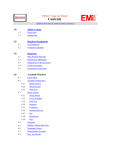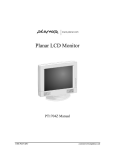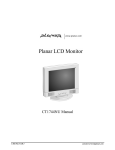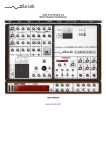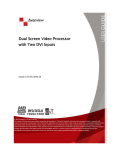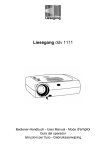Download Product Manual
Transcript
PLANAR LCD MONITOR PT1814NUV MANUAL www.planar.com Preface PREFACE FCC Compliance Statement Note: This equipment has been tested and found to comply with the limits for a Class B digital device, pursuant to Part 15 of the FCC Rules. These limits are designed to provide reasonable protection against harmful interference when the equipment is operated in a residential installation. This equipment generates, uses, and can radiate radio frequency energy and, if not installed and used in accordance with the instruction manual, may cause harmful interference to radio communications. However, there is no guarantee that interference will not occur in a particular installation. If this equipment does cause harmful interference to radio or television reception, which can be determined by turning the equipment off and on, you are encouraged to try to correct the interference by one or more of the following measures: • Reorient or relocate the receiving antenna. • Increase the separation between the equipment and the receiver. • Connect the equipment into an outlet on different from that to which the receiver is connected. • Consult the dealer or an experienced radio/TV technician for help. Caution: To comply with the limits for an FCC Class B computing device, always use the shielded signal cord and shielded power cord supplied with this unit. The Federal Communications Commission warns that changes or modifications of the unit not expressly approved by the party responsible for compliance could void the user’s authority to operate the equipment. Class B ITE (Following European standard EN 55022, EN55024) Radio Frequency Interference Statement Warning: This is a Class B product. In a domestic environment, this product may cause radio interference in which case the user may be required to take adequate measures. Canadian Doc Notice For Class B Computing Devices This digital apparatus does not exceed the Class B limits for radio noise emissions from digital apparatus as set out in the Radio Interference Regulation of the Canadian Department of Communications. “Le présent appareil numérique n’émet pas de bruits radioélectriques dépassant les limites applicables aux appareils numériques de la class B prescrites dans le Règlement sur le brouillage radioélectrique édicté par le ministère des Communications du Canada” i User’s Manual Important Safety Instructions Please read the following instructions carefully. This manual should be retained for future use. 1. To clean the LCD Monitor screen, first, make sure the Monitor is in the power off mode. Unplug the Monitor from its power source before cleaning it. Do not spray liquid cleaners directly onto the unit. Stand away from the LCD Monitor and spray cleaning solution onto a rag. Without applying excessive pressure, clean the screen with the slightly dampened rag. 2. Do not place your LCD Monitor near a window. Exposing the Monitor to rain, water, moisture or sunlight can severely damage it. 3. Do not place anything on top of the Monitor-to-PC signal cord. Make sure the cord is placed in an area where it will not be stepped on. 4. Do not apply pressure to the LCD screen. Excessive pressure may cause permanent damage to the display. 5. Do not remove the cover or attempt to service this unit by yourself. You may void the warranty. Servicing of any nature should be performed only by an authorized technician. 6. Safe storage of the LCD Monitor is in a range of minus 20 to plus 65 degrees Celsius (68°F-149°F). Storing your LCD Monitor outside this range could result in permanent damage. 7. If any of the following occurs, immediately unplug your Monitor and call an authorized technician. • The power or Monitor-to-PC signal cord is frayed or damaged. • Liquid has been spilled onto the Monitor, or it has been exposed to rain. • The Monitor has been dropped or the case has been damaged. 8. The appliance should be disconnected from the mains by pulling the mains power cord/mains plug. 9. The socket-outlet shall be installed near the equipment and shall be easily accessible. ii Table of Contents TABLE OF CONTENTS PREFACE .............................................................................................................................................................................. I TABLE OF CONTENTS ..................................................................................................................................................III CHAPTER 1 ..........................................................................................................................................................................1 Your new LCD Monitor!............................................................................................................................1 Unpacking................................................................................................................................................1 Identifying Components ...........................................................................................................................1 The LCD Monitor — Front View .............................................................................................................................1 The LCD Monitor — Rear View ..............................................................................................................................3 Adjusting the Viewing Angle ....................................................................................................................3 Positioning ...............................................................................................................................................4 Connecting AC Power..............................................................................................................................4 Connecting Video ....................................................................................................................................4 Connecting the Stereo Speakers .............................................................................................................5 Connecting the Optional Touch Screen ...................................................................................................5 Power Management System ....................................................................................................................6 CHAPTER 2 ..........................................................................................................................................................................7 The LCD Monitor’s Display Controls ........................................................................................................7 Adjusting the Monitor’s Display ................................................................................................................7 OSD Main Menu ......................................................................................................................................7 APPENDIX A ......................................................................................................................................................................10 TFT LCD Monitor Specifications ............................................................................................................10 APPENDIX B ......................................................................................................................................................................11 APPENDIX C ......................................................................................................................................................................12 Troubleshooting Procedures..................................................................................................................12 APPENDIX D ......................................................................................................................................................................13 Monitor with optional Video input function..............................................................................................13 OSD Menu ..............................................................................................................................................................13 Video Control functions .........................................................................................................................................13 iii CHAPTER 1 The LCD Monitor Your new LCD Monitor! Your LCD Monitor has been designed to be versatile, ergonomic and user-friendly. The LCD Monitor is capable of displaying most standards, from 640 x 480 VGA to 1280 x 1024 SXGA. The digital controls located on the front panel allow the user to easily adjust the Monitor’s display parameters. The LCD Monitor’s small footprint allows you more room in your workspace for other peripherals. Lightweight and compact, the LCD Monitor is the perfect solution for all type of users. You can use the LCD Monitor for everything from making business presentations to playing computer games. The two stereo speakers allow you to further expand your computer’s multimedia capabilities by connecting your computer’s Audio out port to the LCD Monitor’s Audio in port. If you have a complete workstation, the LCD Monitor has the additional feature of an optional wall mountable & VESA Compliance Arm mounted bracket for added convenience. The architecture of the LCD Monitor incorporates an LCD panel that produces a clear display without radiation emission, limiting health concerns. With its low power consumption, the LCD Monitor helps you reduce your power bill. Unpacking Before you unpack your LCD Monitor, prepare a suitable workspace for your LCD Monitor and computer. You need a stable, level and clean surface near a wall outlet. Even though the LCD Monitor uses very little power, you should put it in a location, which allows sufficient airflow to ensure that the LCD Monitor and your computer does not become too hot. Set up your LCD Monitor so that the panel doesn’t face a window where sunlight often comes in. The glare caused by sunlight reflecting off the LCD Monitor’s screen will make it difficult to see. Using a computer for an extended period of time with a poor workstation set-up and incorrect working habits can cause health problems. The science of ergonomics studies the relationship between health and a suitable working environment. There is a section on ergonomics at the end of this chapter. For more information on ergonomics, contact your nearest computer bookstore, or local library. The Internet also has information on this and other subjects. After you unpack your LCD Monitor; make sure the following items are included in the box and in good condition: • LCD Monitor • Monitor-to-PC Analog signal cable (15-pin) • Monitor-to-PC Digital signal cable (24-pin) • USB cable (optional) • S-terminal video cable (optional) • Stereo Jack Audio Cable • Power cord • This user’s manual If you find that any of these items are missing or appear damaged, contact your dealer immediately. Do not throw away the packing material or shipping carton in case you need to ship or store the LCD Monitor in the future. Identifying Components The LCD Monitor has been designed to provide easy access to all controls and peripheral ports. The following figures will help you identify the LCD Monitor’s controls and ports. The LCD Monitor — Front View 1 User’s Manual 1. Display Module The display is an 18.1” diagonal, Active Matrix Liquid Crystal Display (AMLCD). The screen is capable of supporting a maximum resolution of 1280 x 1024 (SXGA). 2. ▲Function ▼Select Buttons These two buttons allow you to select the control functions in the OSD. Press either button to scroll vertically through the main menu and submenu items. Quick Adjust: When the OSD is not active, pressing the ▲ key allows for quick adjustment of the monitor contrast value and pressing the ▼ key allows for quick adjustment of the monitor brightness value. Both are adjusted either up or down via the adjust keys. 3. Adjust Control Buttons The button allows you to increase the menu item value. The button allows you to decrease the menu item value. Quick Adjust: When the OSD is not active, pressing the key allows for quick adjustment of the monitor audio volume up or down via the adjust keys. Pressing the key once indicates which video connector the monitor is using. Pressing the key a second time switches between two active video inputs – either analog D-SUB 15, or digital DVI (digital video interface) 4. Menu Push the Menu select button activates the On Screen Display (OSD). 5. LED Power Mode Indicator This LED indicator stays lit when the power is on and when the monitor is receiving a proper video signal. The LED will blink slowly when the LCD monitor is in power saving mode. 2 Chapter 1 The LCD Monitor — Rear View 1. Input signal ports The monitor can accept signal input from either a traditional analog 15-pin D-Sub VGA connector or the 24pin Digital Video Interface (DVI) connector. If both cables are connected, the Input Port option in the OSD can select which video input is displayed. You can also use the quick key when the OSD is not active. 2. Power input The power cord is attached here. 3. Audio Line In Connect your PC’s Line out to this jack to listen to the PC’s audio through the LCD Monitor’s stereo speakers. (You can also connect your CD-ROM’s Line out to this jack.) 4. Stereo Headphone Jack Stereo headphones may be connected to the headphone jack. 5. Power Switch Powers the monitor ON or OFF. The monitor will enter a power saving mode when video signal is present. 6. USB Hub Connect the USB cable from this port to PC HOST. Up to 4 devices may be connected through this hub. Adjusting the Viewing Angle Your LCD Monitor can be adjusted both horizontally and vertically. 3 User’s Manual Do not force the Monitor past its maximum extension in either direction. You could damage the Monitor and the Monitor stand. Positioning Take a moment to prepare a suitable place to set up your workstation. You need a stable flat dust-free surface with good ventilation. Even though the LCD Monitor has been designed using components that don’t use much power, they still generate quite a bit of heat. Set up your LCD Monitor so that the screen doesn’t face a window where sunlight often comes in. The glare caused by reflected sunlight makes the screen difficult to see. • When positioning the equipment, make sure that the main ports and sockets are easily accessible. • Do not place your LCD Monitor close to a heat source. • Do not place the LCD Monitor in direct sunlight or near a window. Moisture and direct sunlight exposure can be seriously damaging. Connecting AC Power Please refer to the following instructions for connecting AC power to the LCD Monitor. 1. Plug the female end of the power cable into the AC power connector. Plug the male end of the power cord into a wall socket. The plug on the power cable will vary according to the electrical standard in your area. Connecting Video 1. Before connecting your monitor to the PC, please power-off both devices. 2. Connect one end of the VGA signal cable to the PC’s 15-pin VGA port and the other end to the monitor 15pin VGA port. You may also connect the DVI (digital video interface) signal cable to the 24-pin DVT port if your PC is equipped with DVI output. 4 Chapter 1 3. Make sure the signal cable is secure to both the monitor and PC. Tighten the connecting screws to ensure a secure connection. If both analog (15-pin D-sub VGA) and digital (24-pin DVI) input ports are connected at the same time, the signal input can be selected with the OSD (On-Screen Display) menu. Please go to the next chapter for details. Connecting the Stereo Speakers Please refer to the following instructions for connecting the LCD Monitor’s stereo speakers. 1. Connect the 1.5M audio cable to the Line-OUT of your PC’s audio card. 2. Connect the opposite end of the 1.5M audio cable to the LCD Monitor’s line-IN connector. 3. You can adjust the sound volume of the stereo speakers by using the speaker volume control function on the OSD (On-Screen Display). Please refer to the next chapter for details. Connecting the Optional Touch Screen Your LCD Monitor has an optional touch screen feature. If your LCD monitor has this feature, connect the LCD Monitor’s PS/2 connector to your PC’s 9-pin RS232 serial port to enable the touch screen. 1. Connect the PS/2 connector end of the PS/2 to RS232 cable provided with the optional touch screen package to the PS/2 Mini-Din port at the back of the LCD Monitor. 5 User’s Manual 2. Connect the D-sub 9-pin RS232 connector end of the PS/2 to RS232 cable provided with the optional touch screen package to the 9-pin RS232 serial port at the back of your PC. 3. Install the Touch Screen Drivers to your PC. 4. Following the Touch Screen driver guide to align your touch screen positioning. Power Management System The LCD Monitor complies with the VESA DPMS (version 1.0p) power management proposal. The VESA DPMS proposal provides four phases of power saving modes by detecting the horizontal or vertical sync signal. When the LCD Monitor is in power saving mode or detects an incorrect timing, the Monitor screen will go blank, and the power LED indicator will start to blink. 6 CHAPTER 2 The Display Controls The LCD Monitor’s Display Controls This chapter covers the LCD Monitor’s On Screen Display (OSD). Using the OSD you can adjust the contrast, brightness, display position, display clarity, and color temperature, etc. You can also adjust the stereo speaker volume and set OSD parameters. Please read this chapter carefully to get the most out of your LCD Monitor. Adjusting the Monitor’s Display The LCD monitor features an intuitive, menu-driven, On-Screen Display (OSD). You can access the OSD any time that the PC is powered up. If the PC is in a power saving mode, or is powered down, the OSD is inaccessible. NCTION DJUST ENU OSD Main Menu To activate the OSD Main Menu, press the MENU key. To navigate the topline menu, use either the down ▼ or up ▲ function keys to scroll between the main menu choices. The option that is currently selected is highlighted in red and indicated by a pointer. Each main menu has an associated submenu and is further described. Main Menu BASIC SETTING POSITION AUTO-ADJUST Control contrast, brightness, video level, and Gamma, etc. COLOR TEMP. MISCELLANEOUS VIDEO LANGUAGE To control the display colors. INPUT PORT RESET EXIT To select input signal sources between PORT1 (VGA) and PORT2 (Digital DVI). To control the display size, position, clock and phase, etc. To automatically adjust the picture quality and alignment. To control audio volume, OSD positions and to give current display mode information. For S-Video or CVBS input mode selection (optional) To select different OSD text language. To reset the display parameters to the factory default values. Exit OSD Menu. 7 User’s Manual Basic Setting CONTRAST BRIGHTNESS To adjust the contrast level of the display. To adjust the brightness level of the display. VIDEO LEVEL Fine tuning the input signal voltage level. Perform this function whenever the PC graphic card is changed. GAMMA To select a suitable color representation. FRAME To select different border colors (up to 64 colors) when the display is not in full screen size. TO MAIN MENU Return to Main Menu Position CLOCK PHASE DEFAULT SIZE NATIVE SIZE To adjust the display pixel alignment. H-POSITION V-POSITION H-SIZE V-SIZE GRAPH/TEXT To adjust the display position horizontally. TO MAIN MENU Return to Main Menu. To adjust the screen display for focus and clarity. To enable monitor for full screen expansion when resolution is less than the maximum. Display resolutions are set to actual size. To adjust the display position vertically. To adjust the display size horizontally. To adjust the display size vertically. To select either 720X400 or 640x400 DOS modes. Color Temp. Menu 9300 6500 USER To select the color temperature at CIE coordinate 9300° TO MAIN MENU Return to Main Menu. To select the color temperature at CIE coordinate 6500° Select this option to enable the “User Color” field. Individual R, G, B level can be adjusted. Miscellaneous Menu AUDIO VOLUME To adjust the audio volume of the monitor’s speakers. OSD H-POSITION OSD V-POSITION DISPLAY MODE To adjust the horizontal position of the OSD menu. F/W VERSION TO MAIN MENU Select this function to display the firmware version of the monitor. To adjust the vertical position of the OSD menu. Select this function to display the resolution and frame rate of the current screen display. Return to Main Menu. Reset Menu BASIC SETTING POSITION COLOR TEMP. MISCELLANEOUS ALL FUNCTIONS To set the function parameters in the Basic Setting Menu to the default values. TO MAIN MENU Return to Main Menu. To set the function parameters in the Position Menu to the default values. To set the function parameters in the Color Temp. Menu to the default values. To set the function parameters in the Miscellaneous Menu to the default values. To set all adjustable parameters to the default/factory values. 8 Chapter 2 No Signal coming… When the monitor is ON and there is no Video signal received, the monitor will enter the power saving mode. Check the video cable connection. NO SIGNAL COMING… CHECK SIGNAL CABLE MONITOR WILL ENTER POWER SAVING MODE Signal out of monitor’s supported range When the either the display resolution or refresh rate is beyond the capabilities of the monitor, a signal over range message appears. When the signal is over range, the image will not be centered and the warning message appears. Users can pan the display picture with the ▲ / ▼ / / keys. After image adjustment, you should be able to change the settings that provide for a properly displayed image. Consult the appendix for supported resolutions and refresh rates. L OVER RANGE! FUN/ADJ KEY → H-POSITION →V-POSITION 9 APPENDIX A Technical Information TFT LCD Monitor Specifications Model Planar PT1814N LCD Panel 18.1” SXGA Control Functions Power On-Screen Display (OSD) Rocker switch with LED indicator BASIC SETTING----- CONTRAST/BRIGHTNESS/VIDEO LEVEL/GAMMA/FRAME POSITION-------------- CLOCK/PHASE/DEFAULT SIZE/NATIVE SIZE/H-POSITION/V-POSITION/H-SIZE/ V-SIZE/GRAPHIC/TEXT AUTO-ADJUST------- AUTO ADJUST COLOR TEMP. -------9300 /6500 /USER MISCELLANEOUS---AUDIO VOLUME/OSD H-POSITION/OSD V-POSITION/DISPLAY MODE/F/W VERSION VIDEO-------------------CONTRAST/BRIGHTNESS/HUE/VOLUME/SVIDEO MODE/CVPS MODE LANGUAGE-----------ENGLISH/ JAPANESE /DEUTSCH/FRANÇAIS/ESPAÑOL/ITALIANO RESET------------------BASIC SETTING/POSITION/COLOR TEMP./MISCELLANEOUS/ALL FUNCTIONS Display Area (mm) 359.04 x 287.23 mm (18.1 inch diagonal) Response Time 50ms typical Contrast Ratio 300:1 typical 2 Brightness 235 cd/m typical Pixel Pitch (mm) 0.2805 x 0.2805 Viewing Angle Horizontal: 160° Vertical: 160° Display Colors 16.7M Video Interface Analog port: VGA Compatible Analog RGB (15-pin D-Sub)Separate Sync. /Composite Digital port: DDWG compliant Single Link Tmds Digital Visual Interface (DVI) (with port AUTO-detection) Scanning Frequency H/V, Hz (Analog mode) 15-80kHz 50-90 Scanning Frequency H/V, Hz (Digital mode) 30-64kHz 56-85 Number of Factory Preset Mode 41 Power Management Meets VESA DPMS Power Consumption (ON mode/OFF mode) 65 W (typical)/5W (max.) (Measured from AC inlet) Dimensions WxHxD mm 467 x 452 x 242 Net Weight (Kg) Power Supply 9.6 100-240VAC, 50/60Hz single phase Options Wall-mounted bracket, Arm-mounted bracket (VESA Compliance) USB Hub (1 up and 4 down streams), Touch Screen, Video/S-Video adapter cable plus AV audio cable B.N.C. Adapter cable, DVI to DFP Digital Cable Environment Operating Temperature: 0 to 40° C Audio (Two 1 Watt speakers with amplifier) Regulatory Relative Humidity: 10% to 90% Yes UL, CSA, TÜV-GS, CE Mark, VCCI, FCC B DoC, TCO ‘99, EPA Energy Star Program 10 APPENDIX B Supported Timing Timing for Model PT1814N (SXGA Resolution) Item Standards Resolution Dot Clock (MHz) Vertical Scanning Frequency (Hz) Horizontal Scanning Frequency (kHz) Sync Polarity or composite sync (H/V) Operating Mode 1 2 3 4 5 6 7 8 9 10 11 12 13 14 15 16 17 18 19 20 21 22 23 24 25 26 27 28 29 30 31 32 33 34 35 36 37 38 39 40 41 NEC PC98 NEC PC98 MAC 13” mode MAC 16” mode MAC 17” mode VGA VESA VGA VESA VGA VESA VESA VESA VESA SVGA VESA VESA VESA VGA VESA MEDICAL XGA VESA VESA 640x400 640x400 640x480 832x624 1024x768 640x350 640x350 640x400 640x400 640x480 640x480 640x480 640x480 800x600 800x600 800x600 800x600 800x600 720x400 720x400 1024x512 1024x768 1024x768 1024x768 1024x768 1024x768 1152x864 1152x864 1280x960 1280x1024 1280x1024 1280x1024 1024x768 1024x768 1024x768 1024x800 1024x800 1152x900 1152x900 1280x1024 1280x1024 25.20 21.05 30.24 57.28 80.00 25.18 31.50 25.18 31.50 25.18 31.50 31.50 36.00 36.00 40.00 50.00 49.50 56.25 28.32 35.50 46.76 65.00 75.00 78.75 71.64 94.50 108.00 121.5 108.0 108.0 127.0 135.0 64.13 74.25 84.38 81.0 94.5 94.5 108.0 117.0 135.0 70.15 56.42 66.67 74.55 75.02 70.09 85.08 70.09 85.08 59.94 72.81 75.00 85.01 56.25 60.32 72.19 75.00 85.06 70.09 85.04 60 60.00 70.07 75.03 66.13 85.00 75.00 85.00 60.0 60.02 69.85 75.03 59.98 70.04 77.07 72.87 85.53 66.00 76.64 67.19 76.10 31.50 24.83 35.00 49.73 60.24 31.47 37.86 31.47 37.86 31.47 37.86 37.50 43.27 35.16 37.88 48.08 46.88 53.67 31.47 37.93 34.38 48.36 56.48 60.02 53.96 68.68 67.50 77.09 60.0 63.98 74.88 79.98 48.29 56.59 62.04 60.99 71.59 61.84 71.81 71.69 81.13 -/-/-/-/-/+/+/-/+ -/+ -/-/-/-/+/+ +/+ +/+ +/+ +/+ -/+ -/+ -/-/-/+/+ +/+ +/+ +/+ +/+ +/+ +/+ +/+ +/+ H+V H+V H+V H+V H+V H+V H+V H+V H+V A/D A A/D A/D A/D A/D A/D A/D A/D A/D A/D A/D A/D A/D A/D A/D A/D A/D A/D A/D A/D A/D A/D A/D A/D A/D A/D A/D A/D A/D A A A A A A A A A A A VESA VESA VESA VESA VESA VESA VESA SUN SUN SUN SUN SUN SUN SUN SUN SUN *A=Analog Mode; D=Digital Mode *Once a mode is optimized, there is no need to make any further adjustment as long as the VGA card remains unchanged. *Specifications are subject to change without notice. 11 APPENDIX C Troubleshooting Troubleshooting Procedures This LCD Monitor was pre-adjusted in the factory with standard VGA timing. Due to output timing differences among various VGA cards, you may initially experience an unstable or unclear display when a new display mode or new VGA card is selected. This LCD Monitor Supports Multiple VGA Modes. Refer to Appendix B for a listing of the factory preset modes supported by this LCD Monitor. PROBLEM: Display is Unclear and Unstable To stabilize and clarify your display, follow this procedure in this order: 1. It’s best to adjust the display on a screen displaying of vertical lines. In Windows, load a wallpaper bitmap that has vertical lines in it. (Or you can the select window shut down screen) 2. After you have the wallpaper loaded, open the OSD and select the “Clock” function. Press the top (or bottom) Adjustment Control button and continue pressing the button until you see vertical dark and light lines across the screen. 3. When you can see distinct light and dark vertical bands, stop pressing the Adjustment Control button. Now press the opposite (top or bottom) Adjustment Control button. The vertical dark and light bands will decrease in number. Keep pressing the button until the distinct bands disappear and you have a clear display. 4. Next press the Function Control button to choose the “Phase” function. The Phase will adjust the horizontal display. Press the top (or bottom) Adjustment Control button and you will see horizontal dark and light lines appear. The number of lines increases as you press the button. Now press the bottom (or top) Adjustment Control button until the lines disappear and you have a clear display. PROBLEM: There is no LCD Display If there is no display on the LCD, please perform the following steps: 1. Make sure that the power indicator on the LCD Monitor is lit, all connections are secure, and the system is running on the correct timing. Refer to the Appendix B for information on timing. 2. Turn off the LCD Monitor and then turn it back on again. Press the upper Function Control button (refer to Chapter 2) once and then press either the upper or lower Adjustment Control button several times. If there is still no display, press the other Adjustment Control button several times. 3. If step 2 doesn’t work, connect your PC system to another external CRT Monitor. If your PC System function properly with a CRT Monitor but it does not function with the LCD Monitor and the LCD Monitor’s power LED is blinking, the output timing of the PC’s VGA card may be out of the LCD’s synchronous range. Please change to an alternate mode listed in Appendix B or replace the VGA card and repeat steps 1 and 2. 4. If the PC (or Notebook PC) doesn’t function with the CRT monitor neither, check BIOS to see if there is a Simultaneous Display setting under the display mode item. Set the BIOS display mode to Simultaneous Display or CRT and try again. If there is still no display, then there may be a problem with your system. Contact technical support. 5. If the power LED is not lit, check to see if the AC power connector is securely connected. If the power LED is not lit, please contact your dealer for assistance. 12 APPENDIX D Optional Video input function Monitor with optional Video input function If your LCD Monitor is with Video input function, the display can be directly connected to a Video device such as VCR, DVD, camcorder etc. for Video display. The Monitor is compatible with NTSC/PAL systems. OSD Menu The control functions of Video display setting are listed under “Video” function on the Main menu. Continue pressing the Function buttons to select the Video function. Press the Adjustment buttons to enter the sub-menu for video control. Video Control functions Once the Video function is selected, the input signal source is switched to Video input. If the input signal is from S-video terminal, this message will be shown for a few seconds. If the input signal is from the RCA plug, this message will be shown for a few seconds. When the Video function is selected from OSD Menu without active Video input signal, you can use Function control buttons select VGA, CVBS, or S-Video input signal. When the monitor is in the Video mode, you can scroll through the following functions by continue pressing the Function buttons. To adjust the Contrast level of the display. To adjust the Brightness level of the display. To adjust the audio volume of the monitor’s speakers To switch from Video mode to VGA input or vice versa. To adjust colors. To select full sampling rate (Mode 0) or half sampling rate (Mode 1). To set the display parameters to the factory set default values. When the above OSD menu is not active, the following functions are available for quick adjustment. 13 User’s Manual Contrast: Press the first button to activate the Contrast control function. Use the Adjustment keys to increase/ decrease contrast level. Brightness: Press the second button to activate the Brightness control function. Use the Adjustment keys to increase/ decrease Brightness level. Volume Press the third button to activate the Volume control function. Use the Adjustment keys to increase /decrease Volume. Video Signal Press the fourth button to activate Video input control function. Use Adjustment keys to switch between S-Video and CVBS signals sources. VGA Signal Press the fifth button to activate the Video/VGA signal function. Use Adjustment keys switch between Video/VGA signals. 14





















